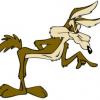The lift force produced by a wing is given by:
liftMagnitude = CL * dynamicPressure * wingArea
dynamicPressure = 0.5 * airDensity * square(airSpeed)
CL = lift coefficient, which depends on the aerofoil and the angle of attack.
The lift acts in a direction perpendicular to the local airflow (this is not the same as the wing "up" direction).
If the wing isn't stalled, then a fair approximation for CL is CL = CL0 + alpha * 0.1 where alpha = angle of attack in degrees. However, for general flight you need to have lift/drag etc calculations over the whole range of angles.
CL0 is the coefficient of lift when the angle of attack is zero. For symmetric aerofoils this is zero. For asymmetric aerofoils this may go up to to 0.3 or so.
You'll also need to calculate the drag (which acts in the direction of the local airflow), and the pitching moment - the torque around the direction perpendicular to the drag and lift directions. When you look info about this it typically indicates the pitching moment assuming the lift force is applied at the "quarter chord" point - i.e. 25% of the way back from the leading edge of the wing.
Also - if you're representing the plane with a single lift/drag/pitching force/torque you'll also need additional terms to represent things like the rolling moment due to sideways movement etc.
Alternatively you can represent the plane with multiple lifting surfaces. If you do this make sure that the airflow is calculated taking into account the rotational velocity of the plane itself (otherwise if you roll the plane, then centralise the stick, the plane will carry on rolling etc).
I'm afraid if you're writing a simulator you can't neglect any of these things, and it's worth getting a handle on them before getting too far with the coding. There's an old simulator I wrote with source code: http://rowlhouse.co.uk/sss/ A new version, using the same system of representing planes using multiple (partly interacting) lifting surfaces is available at http://rowlhouse.co.uk/PicaSim/ - no source code for this, but you can use it to display graphically the CL/CD/CM curves and lift/drag for each component in the plane, and see how they're affected by changing the controls (you're welcome to reverse engineer this!).






